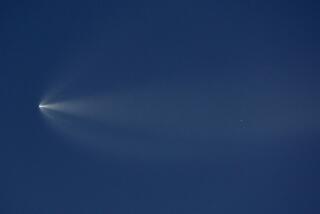SpaceX’s Falcon Heavy rocket flung that Tesla car on a path that goes beyond Mars

The Tesla Roadster that launched Tuesday on the first test flight of SpaceX’s powerful Falcon Heavy rocket is heading farther into space than expected.
The Tesla Roadster that launched Tuesday on the first test flight of SpaceX’s powerful Falcon Heavy rocket is heading farther into space than expected.
The red car — along with a dummy in the driver’s seat named “Starman” — were targeting an elliptical, or egg-shaped, orbit around the sun that would at times get close to Mars. On Tuesday night, SpaceX Chief Executive Elon Musk tweeted that the vehicle’s trajectory had “exceeded Mars orbit and kept going to the Asteroid Belt.”
The car isn’t there yet, though, and won’t be for many months, at least. Musk’s tweet means the car is on a trajectory to go into a much larger elliptical orbit around the sun that will still cross Mars’ orbit from time to time, but push out farther than initially anticipated, said Clifford V. Johnson, a professor in the physics and astronomy department at USC.
“Either way, they’ve shown they can get something to Mars or the vicinity of Mars, and that’s great,” he said of SpaceX. “They’ve demonstrated that they can get something that big off the surface of the Earth, into Earth orbit, recover most of the vehicle to make the whole thing really cheap … and then further extend the [payload’s path] beyond Earth orbit toward Mars.”
On Wednesday, the U.S. Air Force Space Command tweeted that it added a Tesla Roadster to the U.S. satellite catalog.
The car reached its current trajectory after performing several crucial maneuvers.
About two minutes after liftoff from Florida’s Kennedy Space Center on Tuesday afternoon, the Falcon Heavy’s two side boosters separated from the rocket as expected and began to return to Earth, later sticking the landing in a simultaneous touchdown.
About three minutes after launch, as planned, the rocket’s center core separated from the second stage, which continued to carry the Tesla into space.
Inside the Tesla was a stowaway: a little Hot Wheels version of the car, containing a tiny replica of the “Starman” dummy.
SpaceX, which is based in Hawthorne and whose full name is Space Exploration Technologies Corp., tried to land the center core on a floating platform in the Atlantic Ocean, but the booster was lost when it hit the water at about 300 mph and about 328 feet from the platform, taking out two of the platform’s thrusters and scattering debris on the deck.
As projected, the second-stage engine shut down and then restarted twice before embarking on an “experimental long coast” in deep space — including through the high-radiation Van Allen belts that surround Earth — for about six hours.
That maneuver was intended to demonstrate to the U.S. Air Force that the Falcon Heavy could meet specific orbit-insertion requirements for the heaviest national security satellites.
Then the second-stage engine successfully restarted one more time to propel the Tesla toward its intended orbit. The final burn likely took place right over Los Angeles around 6:30 p.m. Pacific time and would have been visible to the naked eye, said Jonathan McDowell, an astrophysicist at the Harvard-Smithsonian Center for Astrophysics.
Launches for the National Reconnaissance Office typically require a rocket to coast in space for several hours before restarting its second-stage engine to deliver a satellite to its orbit, so the latter part of SpaceX’s mission was one of the most significant parts of this demonstration, McDowell said. Where the car ended up afterward was less important, he added.
“It’s just a proof of, ‘OK, we know how this rocket works, and it works well enough to send a decent payload well beyond the Earth,’ ” McDowell said. “Mars comes into it because they were confident they could get it that far, and plus, Elon’s all about Mars.”
One of Musk’s long-standing goals has been to colonize Mars. He has said his next-generation rocket and spaceship system, known as BFR, will take people to the Red Planet.
Twitter: @smasunaga
UPDATES:
3:05 p.m.: This article was updated with details about the U.S. satellite catalog.
1:10 p.m.: This article was updated with details about the Tesla model car inside the Tesla Roadster.
This article was originally published at noon.







